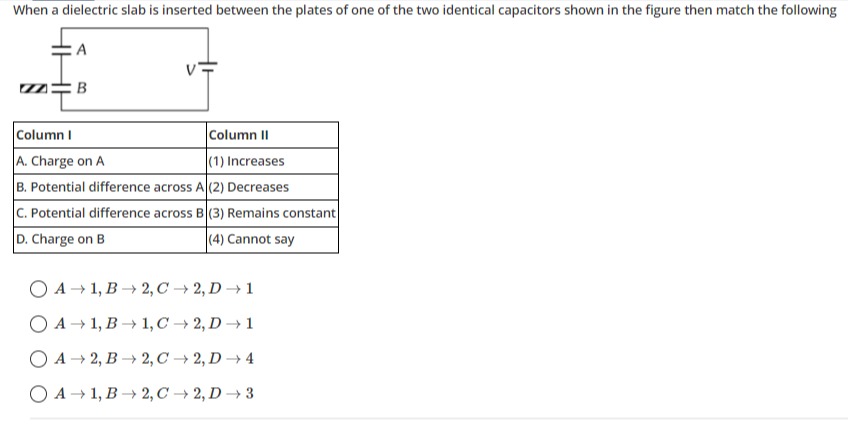Question
Question: When a dielectric slab is inserted between the plates of one of the two identical capacitors shown i...
When a dielectric slab is inserted between the plates of one of the two identical capacitors shown in the figure then match the following

Charge on A
Potential difference across A
Potential difference across B
Charge on B
A→ 1, B→ 1, C → 2, D→ 1
Solution
The problem describes a circuit with two identical capacitors, A and B, connected in series with a voltage source V. A dielectric slab is then inserted into capacitor B. We need to determine how the charge and potential difference across each capacitor change.
Let the initial capacitance of both capacitors be C. So, CA=CB=C.
Initial State:
-
Equivalent Capacitance: Since A and B are in series, the initial equivalent capacitance Ceq,i is: Ceq,i1=CA1+CB1=C1+C1=C2
Ceq,i=2C
-
Total Charge: The total charge supplied by the battery is Qi=Ceq,iV: Qi=2CV
-
Charge on each capacitor: In a series combination, the charge on each capacitor is the same as the total charge: QA,i=QB,i=Qi=2CV
-
Potential Difference across each capacitor: VA,i=CAQA,i=CCV/2=2V
VB,i=CBQB,i=CCV/2=2V
Final State (after inserting dielectric in B):
Let the dielectric constant be K. Since a dielectric slab is inserted into capacitor B, its capacitance increases to CB′=KCB=KC. Capacitor A remains unchanged, so CA′=CA=C.
-
Equivalent Capacitance: The new equivalent capacitance Ceq,f is: Ceq,f1=CA′1+CB′1=C1+KC1=KCK+1
Ceq,f=K+1KC
-
Comparison of Equivalent Capacitance: Since K>1 for a dielectric, let's compare Ceq,f with Ceq,i:
Ceq,f=K+1KC and Ceq,i=2C
We compare K+1K with 21.
2K vs K+1. Since K>1, 2K>K+1.
Therefore, K+1K>21, which means Ceq,f>Ceq,i.
-
Total Charge: The total charge supplied by the battery is Qf=Ceq,fV. Since Ceq,f>Ceq,i and V is constant, Qf>Qi.
-
Charge on each capacitor: In a series combination, the charge on each capacitor is equal to the total charge: QA,f=QB,f=Qf.
Since Qf>Qi, both QA and QB increase.
- A. Charge on A: Increases (1)
- D. Charge on B: Increases (1)
-
Potential Difference across each capacitor:
-
Potential difference across A (VA,f): VA,f=CA′QA,f=CQf=CK+1KCV=K+1KV
Comparing VA,f with VA,i: VA,f=K+1KV and VA,i=2V
As established, K+1K>21 for K>1.
Therefore, VA,f>VA,i, meaning VA increases.
- B. Potential difference across A: Increases (1)
-
Potential difference across B (VB,f): VB,f=CB′QB,f=KCQf=KCK+1KCV=K+11V
Comparing VB,f with VB,i: VB,f=K+11V and VB,i=2V
Since K>1, K+1>2. Therefore, K+11<21.
Thus, VB,f<VB,i, meaning VB decreases.
- C. Potential difference across B: Decreases (2)
-
Summary of Matches:
- A. Charge on A → (1) Increases
- B. Potential difference across A → (1) Increases
- C. Potential difference across B → (2) Decreases
- D. Charge on B → (1) Increases
Matching this with the given options, the correct option is: A→ 1, B→ 1, C → 2, D→ 1.
